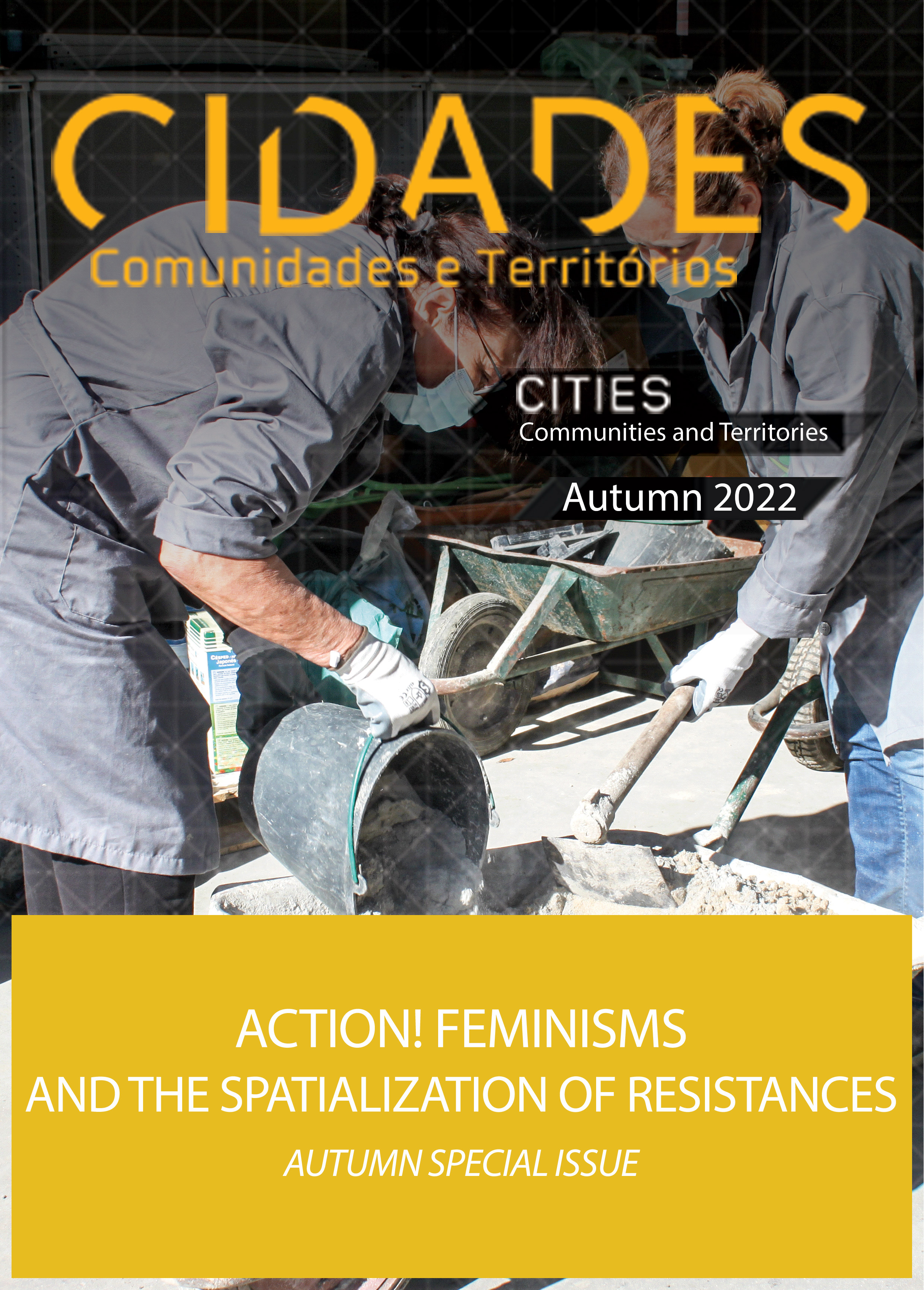Embodying the virus: epistemic and performative interventions to disciplinary hegemony in architecture and urbanism
Keywords:
feminist architectures, feminism, performativity, hegemony, epistemesAbstract
Our everyday experiences, formed in our domestic and public lives, produce and hold significant research data that, if acknowledged, observed and analyzed, can lead to new epistemological approaches to architecture and urban design. With everyday experiences as sources, Feminist Architecture emerges against the normative subjection that demarcates and fixates the predominant socio-economic order in our bodies. The production and reproduction of hegemonic knowledge in the discipline of architecture, as well as its methodologies, have been disputed and countered by the feminist movement, especially since the last decades of the 20th century. Specifically, feminism has challenged the hegemonic view of the discipline, which is based on norms, values and ideas that allows material power to be exercised. Historically this results in the erasure, misappropriation and appropriation of the work performed by feminized bodies, and others. Rethinking architectural epistemologies, implies engaging and exploring the life-territory-body-spatiality bond to expand the foundations of the discipline. Thus, this article seeks to reflect on how we can stretch architecture, while challenging traditional norms on the understanding of space, as a category and concept, in the potentially productive crisis that Feminist Architecture presents. A perspective and alliance with the epistemology of everyday lives, of bodies-territories, to point out the situated analytical possibilities of different epistemic and performative forms of intervening, challenging and contesting the disciplinary hegemony of urban and architectural studies.
References
Bhattacharya, T. (Ed.) (2017). Social Reproduction Theory: Remapping Class, Recentering Oppression. London: Pluto Press.
Baydar Nalbantoglu, G. (1998). Toward postcolonial openings: rereading Sir Banister Fletcher's “History of Architecture”. Assemblage, 35, 6–17.
Butler, J. (2019). Corpos que importam. São Paulo: Crocodilo Edições.
Butler, J. (2014). Precarious Life: The Powers of Mourning and Violence. London, New York: Verso.
Carbajal, M. & Segato, R. (2010). Las mujeres nunca han sufrido tanta violencia doméstica como en la Modernidad, Página 12. https://www.pagina12.com.ar/diario/dialogos/21-139835-2010-02-08.html.
Carrillo, J. (2007). Entrevista com Beatriz Preciado. Cadernos Pagu, 28, 375–405. https://doi.org/10.1590/S0104-83332007000100016.
de Jong, A. (2020). The Multiplicity of Other. Values for survival: Cahier 1, 89–97 https://openresearch.amsterdam/en/page/56356/chapter-3-multiplicity-of-other.
Fanon, F. (1963). The Wretched of the Earth. New York: Grove Press (original em francês 1961).
Federici, S. (2021). O patriarcado do salário: Notas sobre Marx, gênero e feminismo. São Paulo: Boitempo.
Federici, S. (2017). Calibã e a bruxa: mulheres, corpo e acumulação primitiva. São Paulo: Elefante.
Foucault, M. (1988). História da sexualidade I: A vontade de saber. Rio de Janeiro, Edições Graal, 1988 (original em francês 1976).
Godinho Lima, A. G. (2012). Arquitetas e arquiteturas na América Latina do século XX. São Paulo: Altamira.
Haraway, D. (2009). Saberes localizados: a questão da ciência para o feminismo e o privilégio da perspectiva parcial. Cadernos Pagu, 5, 7–41, https://periodicos.sbu.unicamp.br/ojs/index.php/cadpagu/article/view/1773
Kristeller, P. O. (1944-1945). Humanism and Scholasticism in the Italian Renaissance, Byzantion, 17, 346–374.
Lefebvre, H. (2000). La production de l’espace. Paris: Anthropos
Lerner, G. (1986). The Creation of Patriarchy. New York, London: Oxford University Press.
Lorey, I. (2012). Estado de inseguridad. Gobernar la precariedad. Madrid: Traficantes de Sueños.
Moisset, I. et al. (2015). Un día/una arquitecta. https://undiaunaarquitecta.wordpress.com/indice/indice-cronologico/
Molyneux, M. (2010) Mobilization Without Emancipation? Women's interests, the state, and revolution in Nicaragua. In M. N. Krook, & S. Childs (Eds.), Women, gender, and politics: a reader (pp.21–28). Oxford: Oxford University Press.
Muxí Martínez, Z. (2018). Mujeres, casas y ciudades: más allá del umbral. Barcelona: dpr-barcelona.
Nevejan, C. (2020). Multiplicity of Other 3. Values for Survival: Cahier 1, 85–120 https://openresearch.amsterdam/en/page/56356/chapter-3-multiplicity-of-other.
Novas Ferradás, M. (2021). Arquitectura y género. Una introducción posible. Santa Cruz de Tenerife: Melusina.
Ribeiro, A. C. T. (2010). Dança dos sentidos: na busca de alguns gestos. In P. B. Jacques & F. D. Britto (Eds.), Corpocidade: debates, ações e articulações (pp. 24–41). Salvador: EDUFBA.
Rose, G. (1993). Feminist & Geography: The limits of geographical knowledge. Cambridge, Oxford: Polity Press.
Ruiz Menéndez, O. (2021). ¿Qué pasa con la casa? (y las violencias contra mujeres y niñas)? Píkara Magazine, https://www.pikaramagazine.com/2021/06/que-pasa-con-la-casa-y-las-violencias-contra-mujeres-y-ninas/.
Said, E. W. (1983). The World, the Text and the Critic. Cambridge, Massachusetts: Harvard University Press Cambridge.
Salem, S. (2020). Gramsci in the Postcolony: Hegemony and Anticolonialism in Nasserist Egypt. Theory, Culture and Society, 21, https://doi.org/10.1177/0263276420935178.
Sanchez Llorens, M., Feliz Ricoy, S., Amann y Alcocer, A., & Martella, F. (2021). Cuidados. Actas Primer Congreso Internacional Feminista Sobre Arquitectura y Cuidados. Madrid: Universidad Politécnica de Madrid. https://issuu.com/congresoarquitecturaycuidados/docs/actas_congreso_arquitectura_y_cuidados.
Segato, R. L. (2003). Las Estructuras Elementales de la Violencia. Buenos Aires: Prometeo.
Segato, R. L. (2013). La escritura en el cuerpo de las mujeres asesinadas en Ciudad Juárez. Territorio, soberanía y crímenes de segundo estado. Buenos Aires: Tinta Limón.
Soihet, R. (1989). Condição feminina e formas de violência: mulheres pobres e ordem urbana, 1890-1920. Rio de Janeiro: Forense Universitária.
Sontag, S. (1977). Illnes as Metaphor. New York: Farrar, Straus and Giroux.
Spivak, G. C. (2002). ¿Puede hablar la subalterna? Asparkía: Investigació Feminista, 13, 207–214, https://doi.org/10.6035/Asparkia.
Tavares, R. B., & Ramos, D. H. . (2021). Indisciplina Epistemológica: Viradas metodológicas para o campo da Arquitetura e Urbanismo. Indisciplinar, 7(2), 232–277. https://periodicos.ufmg.br/index.php/indisciplinar/article/view/38147.
Tavares, R. B. & Bonadio, M. G. (2021). Ao encontro do corpo: teorias da performatividade para um debate diferencial sobre espaço urbano. Revista Brasileira de Estudos Urbanos e Regionais, 23, https://doi.org/10.22296/2317-1529.rbeur.202115.
Tavares, R. B. (2015). Indiferença à Diferença: espaços urbanos de resistência na perspectiva das desigualdades de gênero [Tese de doutorado. Programa de Pós-graduação em Urbanismo, UFRJ].
Downloads
Published
Issue
Section
License
Copyright (c) 2022 Rossana Brandao Tavares, María Novas, Laura Sarmiento

This work is licensed under a Creative Commons Attribution-NonCommercial-NoDerivatives 4.0 International License.
CIDADES, Comunidades e Territórios by DINÂMIA'CET-Iscte is licensed under a CC-BY licence.






